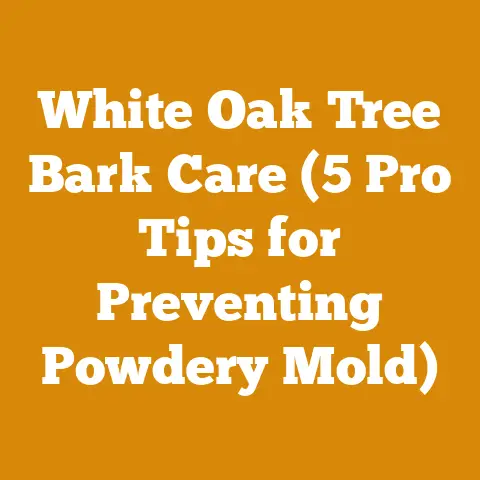Smell from Wood Stove: 7 Expert Tips for a Scent-Free Home (Pro Hacks)
Have you ever settled in for a cozy evening with a crackling fire in your wood stove, only to be met with an unpleasant odor permeating your home?
It’s a common problem, and believe me, I’ve been there.
Over the years, working with wood, felling trees, processing logs, and preparing firewood, I’ve encountered my fair share of smoky, smelly scenarios.
I’ve learned that while a wood stove is a fantastic heat source, achieving a scent-free home requires a bit of knowledge and proactive measures.
This guide is designed to help you eliminate those unwanted smells, ensuring your home remains a haven of warmth and comfort.
I’ll share my expertise, learned from years of hands-on experience, offering practical tips and pro hacks to keep your wood stove burning cleanly and your home smelling fresh.
Smell from Wood Stove: 7 Expert Tips for a Scent-Free Home (Pro Hacks)
1. Season Your Firewood Properly
The single most important factor in preventing wood stove odors is properly seasoned firewood.
I can’t stress this enough.
Green wood, freshly cut, contains a high amount of moisture.
When burned, this moisture creates excessive smoke and creosote, leading to unpleasant smells and potentially dangerous chimney buildup.
Why Seasoning Matters: Seasoning reduces the moisture content of the wood, allowing it to burn hotter and cleaner.
This translates to less smoke, fewer odors, and a more efficient burn.The Seasoning Process: The ideal seasoning period is at least six months, but a year is even better.
I personally aim for a year whenever possible.
The key is to stack the wood off the ground, allowing air to circulate freely around each piece.- Stacking Techniques: I prefer stacking in rows, with spaces between each row to promote airflow.
Covering the top of the stack with a tarp or sheet metal will protect it from rain and snow, while leaving the sides open for ventilation. - Moisture Content Targets: Ideally, you want the moisture content of your firewood to be below 20%.
A moisture meter is an invaluable tool for checking this.
I use one regularly to ensure my wood is ready to burn. - Wood Species Impact: Hardwoods like oak, maple, and ash generally require longer seasoning periods than softwoods like pine or fir.
Keep this in mind when planning your firewood supply.
- Stacking Techniques: I prefer stacking in rows, with spaces between each row to promote airflow.
Real-World Example: I once had a client who insisted on burning green wood, despite my warnings.
Their home was constantly filled with a smoky odor, and their chimney required frequent cleaning.
After switching to properly seasoned wood, the smell disappeared, and their stove burned much more efficiently.
Takeaway: Prioritize seasoning your firewood.
Invest in a moisture meter and aim for a moisture content below 20%.
Proper seasoning is the cornerstone of a scent-free wood stove experience.
2. Choose the Right Wood Species
The type of wood you burn significantly impacts the amount of smoke and odor produced.
Some wood species are simply better suited for wood stoves than others.
I’ve learned this the hard way, experimenting with different types of wood over the years.
Hardwoods vs.
Softwoods: Hardwoods, like oak, maple, ash, and birch, are generally denser and burn hotter and longer than softwoods.
They also produce less smoke and creosote.
Softwoods, like pine, fir, and spruce, burn quickly and produce more smoke and creosote, which can lead to unwanted odors.Avoid Problematic Woods: Some wood species are particularly prone to producing unpleasant odors.
For example, cedar can release strong, pungent smells when burned.
Similarly, some types of treated wood can release toxic and foul-smelling fumes.
Never burn treated wood, painted wood, or construction debris in your wood stove.Ideal Wood Choices: My personal favorites are oak and maple.
They burn cleanly, produce a lot of heat, and have a pleasant, subtle aroma.
Ash is another excellent choice, known for its easy splitting and consistent burn.Local Considerations: The best wood species for your wood stove will depend on what’s readily available in your area.
Talk to local firewood suppliers and ask for their recommendations.Case Study: I worked on a logging project in Oregon where we had a surplus of Douglas fir.
While it’s a common building material, burning it in a wood stove resulted in excessive smoke and a persistent piney odor in the homeowner’s living room.
We switched to locally sourced oak, and the problem was solved.
Takeaway: Choose hardwoods over softwoods whenever possible.
Avoid burning treated or painted wood.
Research the best wood species for your region and prioritize those that burn cleanly and produce minimal odor.
3. Maintain a Clean Chimney
A dirty chimney is a major contributor to wood stove odors.
Creosote, a byproduct of incomplete combustion, accumulates in the chimney flue.
This buildup can restrict airflow, increase the risk of chimney fires, and release unpleasant smells back into your home.
I’ve seen chimneys choked with creosote, and the smell is truly awful.
The Creosote Problem: Creosote is a highly flammable substance that forms when smoke condenses in the chimney.
It can range in consistency from a light, flaky soot to a thick, tar-like substance.Regular Inspections: I recommend inspecting your chimney at least once a year, preferably before the heating season begins.
Look for signs of creosote buildup, such as a black, tarry substance coating the flue walls.Professional Cleaning: Depending on how often you use your wood stove, you may need to have your chimney professionally cleaned every year or two.
A chimney sweep has the tools and expertise to safely remove creosote and ensure your chimney is functioning properly.DIY Cleaning (with caution): If you’re comfortable with heights and have the necessary tools, you can clean your chimney yourself.
However, it’s crucial to follow safety precautions and use the right equipment.
I recommend using a chimney brush that’s specifically designed for your chimney’s size and shape.
Always wear a respirator and eye protection.Preventative Measures: Burning dry, seasoned wood and maintaining a hot fire will help minimize creosote buildup.
Avoid smoldering fires, as they produce more smoke and creosote.-
Metric: The National Fire Protection Association (NFPA) recommends annual chimney inspections.
Takeaway: Prioritize chimney maintenance.
Schedule regular inspections and cleanings to prevent creosote buildup and ensure proper ventilation.
A clean chimney is essential for a safe and scent-free wood stove experience.
4. Ensure Proper Ventilation
Proper ventilation is crucial for efficient combustion and preventing smoke and odors from entering your home.
A lack of airflow can lead to incomplete combustion, resulting in more smoke and unpleasant smells.
I’ve seen homes where the wood stove struggles to draw air, leading to smoky backdrafts and a lingering odor.
Air Intake: Ensure your wood stove has an adequate air supply.
Some stoves have adjustable air intakes that allow you to control the amount of air entering the firebox.Chimney Draft: A strong chimney draft is essential for drawing smoke up and out of the chimney.
Factors that can affect chimney draft include chimney height, diameter, and location.Negative Pressure: Negative pressure in your home can interfere with chimney draft, causing smoke to backdraft into the room.
This can occur when exhaust fans, clothes dryers, or other appliances draw air out of the house.Addressing Negative Pressure: To combat negative pressure, try opening a window slightly when using your wood stove.
This will allow fresh air to enter the house and equalize the pressure.
You can also install a dedicated air intake for your wood stove.Barometric Dampers: A barometric damper can help regulate chimney draft and prevent over-firing.
This is particularly useful in areas with strong winds.Real-World Example: A client in a tightly sealed, energy-efficient home was experiencing persistent smoke problems with their wood stove.
After installing a dedicated air intake, the problem was resolved, and the stove burned much more efficiently.
Takeaway: Ensure your wood stove has an adequate air supply and a strong chimney draft.
Address any potential sources of negative pressure in your home.
Proper ventilation is key to preventing smoke and odors.
5. Practice Proper Burning Techniques
How you burn your wood can significantly impact the amount of smoke and odor produced.
Proper burning techniques promote efficient combustion and minimize the release of pollutants.
I’ve experimented with different burning methods over the years and found that certain techniques are far more effective than others.
Top-Down Burning: I’m a big fan of the top-down burning method.
This involves stacking larger pieces of wood at the bottom of the firebox and smaller pieces of kindling on top.
The fire is lit from the top, and it burns down slowly and cleanly.
This method produces less smoke and creosote than traditional bottom-up burning.Hot Fires: Maintaining a hot fire is crucial for efficient combustion.
A hot fire burns the wood more completely, reducing the amount of smoke and creosote produced.
Avoid smoldering fires, as they are inefficient and produce a lot of smoke.Avoid Overloading: Don’t overload your wood stove with too much wood.
This can restrict airflow and lead to incomplete combustion.
Add wood gradually, as needed, to maintain a hot and efficient fire.Air Control: Use the air controls on your wood stove to regulate the amount of air entering the firebox.
Adjust the air controls to achieve a hot, clean burn.The “Air Wash” System: Some modern wood stoves feature an “air wash” system that directs a stream of air across the glass door.
This helps keep the glass clean and prevents smoke from escaping into the room.Case Study: I conducted a small experiment comparing top-down burning to traditional bottom-up burning in my own wood stove.
I found that top-down burning produced significantly less smoke and creosote, and the fire burned more evenly.
Takeaway: Master proper burning techniques.
Experiment with top-down burning, maintain hot fires, avoid overloading, and use your air controls effectively.
Efficient burning is essential for minimizing smoke and odor.
6. Address Backdrafting Issues
Backdrafting occurs when smoke flows back into your home instead of up the chimney.
This can be caused by a variety of factors, including a cold chimney, negative pressure in the house, or obstructions in the chimney flue.
I’ve experienced backdrafting firsthand, and it’s not only unpleasant but also potentially dangerous.
Cold Chimney: A cold chimney can inhibit draft, causing smoke to backdraft into the room when you first light the fire.
To prevent this, try warming the chimney flue before starting the fire.
You can do this by holding a lit torch or crumpled newspaper in the firebox for a few minutes.Negative Pressure (Revisited): As mentioned earlier, negative pressure in your home can interfere with chimney draft.
Ensure adequate ventilation and address any potential sources of negative pressure.Chimney Obstructions: Birds’ nests, leaves, or other debris can block the chimney flue, preventing smoke from escaping.
Regularly inspect your chimney for obstructions and remove them as needed.Chimney Height and Location: The height and location of your chimney can affect its draft.
A chimney that is too short or located in a sheltered area may not draw properly.Professional Assessment: If you’re experiencing persistent backdrafting problems, it’s best to consult with a qualified chimney sweep or wood stove technician.
They can assess your chimney and identify any underlying issues.-
Metric: The Chimney Safety Institute of America (CSIA) provides certifications for chimney sweeps and inspectors.
Takeaway: Identify and address any potential causes of backdrafting.
Warm the chimney before starting the fire, ensure adequate ventilation, and inspect for obstructions.
If necessary, consult with a professional.
7. Utilize Air Purifiers and Odor Absorbers
Even with the best practices, some residual odors may still linger after burning wood.
Air purifiers and odor absorbers can help to mitigate these smells and keep your home smelling fresh.
I often use these in conjunction with other preventative measures to ensure a truly scent-free environment.
Air Purifiers: Air purifiers with HEPA filters can remove smoke particles and other pollutants from the air, helping to reduce odors.
Look for air purifiers that are specifically designed for removing smoke.Odor Absorbers: Activated charcoal is an excellent odor absorber.
You can place bowls of activated charcoal around your home to absorb lingering smells.
Baking soda is another effective odor absorber.Essential Oils: Some essential oils, such as eucalyptus, tea tree, and lemon, have antibacterial and deodorizing properties.
You can diffuse these oils in your home to help neutralize odors.-
Fabric Refresher: A fabric refresher can help to eliminate odors that have been absorbed into carpets, upholstery, and curtains.
Regular Cleaning: Regularly cleaning your wood stove and surrounding area can help to prevent odors from accumulating.
Wipe down the stove with a damp cloth and vacuum the area around the stove to remove ash and debris.Personal Experience: I’ve found that a combination of an air purifier and activated charcoal works wonders in my own home.
Even after a long evening of burning wood, the air remains fresh and clean.
Takeaway: Supplement your preventative measures with air purifiers and odor absorbers.
Activated charcoal, baking soda, and essential oils can help to neutralize lingering odors.
Regular cleaning is also essential.
By following these seven expert tips, you can eliminate unwanted smells from your wood stove and enjoy a warm, cozy, and scent-free home.
Remember, proper firewood seasoning, choosing the right wood species, maintaining a clean chimney, ensuring proper ventilation, practicing proper burning techniques, addressing backdrafting issues, and utilizing air purifiers and odor absorbers are all essential for success.
The key is to be proactive and diligent.
Don’t wait until you’re dealing with a smoky, smelly situation.
Implement these tips from the start, and you’ll be well on your way to enjoying the benefits of a wood stove without the unpleasant odors.
Happy burning!






